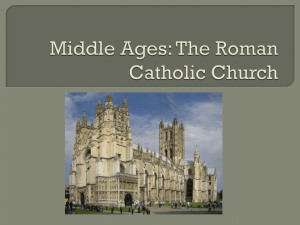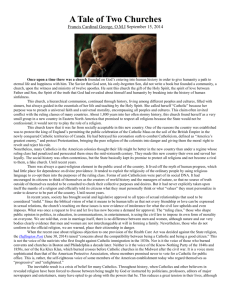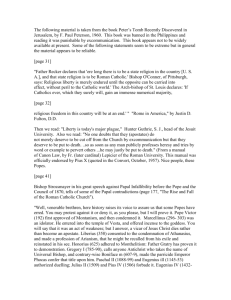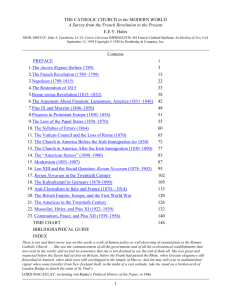Tiffany-Nguyen
advertisement
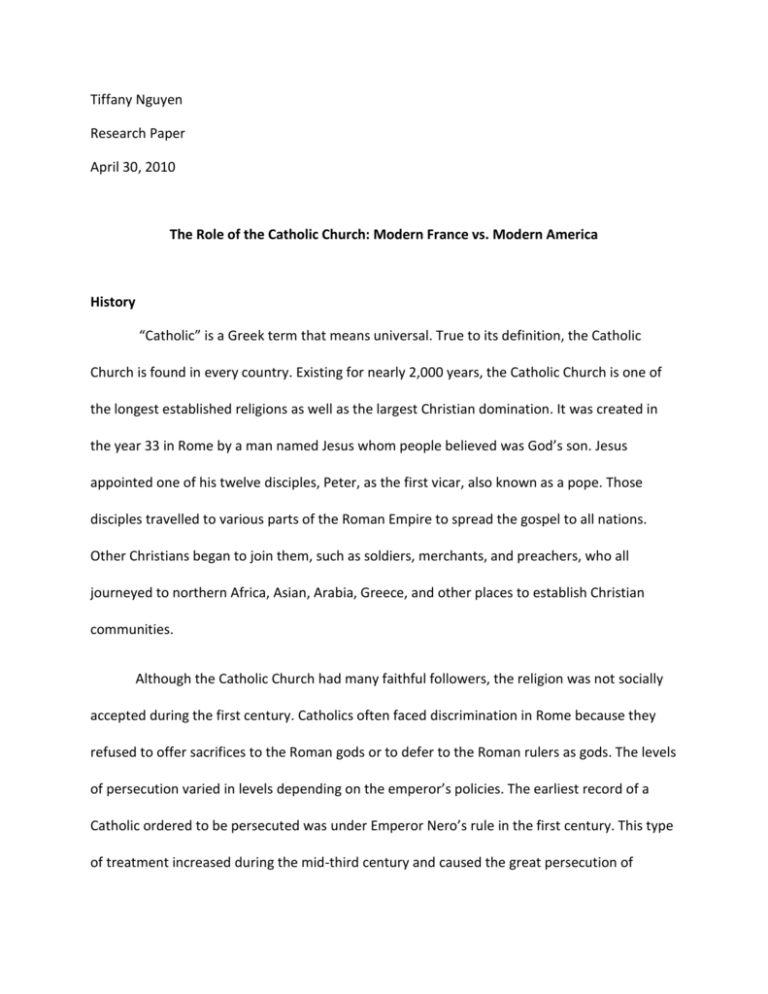
Tiffany Nguyen Research Paper April 30, 2010 The Role of the Catholic Church: Modern France vs. Modern America History “Catholic” is a Greek term that means universal. True to its definition, the Catholic Church is found in every country. Existing for nearly 2,000 years, the Catholic Church is one of the longest established religions as well as the largest Christian domination. It was created in the year 33 in Rome by a man named Jesus whom people believed was God’s son. Jesus appointed one of his twelve disciples, Peter, as the first vicar, also known as a pope. Those disciples travelled to various parts of the Roman Empire to spread the gospel to all nations. Other Christians began to join them, such as soldiers, merchants, and preachers, who all journeyed to northern Africa, Asian, Arabia, Greece, and other places to establish Christian communities. Although the Catholic Church had many faithful followers, the religion was not socially accepted during the first century. Catholics often faced discrimination in Rome because they refused to offer sacrifices to the Roman gods or to defer to the Roman rulers as gods. The levels of persecution varied in levels depending on the emperor’s policies. The earliest record of a Catholic ordered to be persecuted was under Emperor Nero’s rule in the first century. This type of treatment increased during the mid-third century and caused the great persecution of Diocletian and Galerius in the early fourth century. The reason for this was to try and eliminate Christianity as a whole, but instead it lead to the legalization of the religion in 313 and by 380, Christianity had become the state religion of the Roman Empire. In the Middle Ages, after the fall of the Western Roman Empire in 476, the Catholic Church competed with Arianism for the conversion of the barbarian tribes. By 496, there was a steady rise of faith in the West and there was a desire to spread monasteries throughout Europe. These monasteries became major parts of civilization which help preserve craft and artistic skills and maintain intellectual culture in their schools, scriptorias, and libraries. The Visigoths and Lombards eventually broke away from Arianism and fell towards the Catholic Church instead. Pope Gregory the Great was responsible for these conversions and he began a fresh wave of motivation for missionary efforts. Christianity started spreading from others such as Augustine of Canterbury, who was sent from Rome to begin converting the Anglo-Saxons. Saints Colombanus, Boniface, Willibrord, and Ansagar took their religion into northern Europe to spread it to the Germanic, Slavic peoples, Vikings, and Scandinavians. In 910, the Clunic reform of monasteries took place and it put abbots under direct control of the pope rather than the secular control of feudal lords. This important reform eliminated the major source of corruption in the Church and sparked a great monastic renewal. The monasteries, convents, and cathedrals operated most of the schools and libraries, and they helped to promote economic growth. After 1100, some of the older cathedral schools split into lower grammar schools and advance learning schools, in Bologna, then Paris, and next Oxford. The 11th century was a big turning point for Christianity. The religion was permanently divided because of the East-West schism. This dilemma arose over a dispute on whether Constantinople or Rome was head over the church in Sicily. The Western (Latin) branch of Christianity became known as the Catholic Church and the Eastern (Greek) branch was the Orthodox Church. Some Eastern churches have reunited with the Catholic Church, but others claim to have never had any connection to the pope. The two churches still remain separate even though the excommunications were mutually lifted in 1965. This century also saw the Investiture Controversy between the Emperor and the Pope over the right to make church appointments; this caused the first major phase of the struggle between Church and State in medieval Europe. In the 12th century, France witnessed the widespread growth of Catharism, a dualistic theology which taught the ascendency of the soul over the body, accepted suicide, and that matter was evil. The Albigensian Crudase was declared by Pope Innocent III because a papal legate was murdered by the Cathars in 1208. The first papal inquisition was created to prevent future aberrational practices and to rid of the remaining Cathars. These inquisitions were launched by the Church or secular rulers to prosecute heretics in response to threats of invasions or for political purposes. The consequences included punishment by penance, fines, imprisonment, torture or execution by burning. The late 15th and early 16th centuries were an Enlightment age for the Catholic Church. Parishioners had a renewed interest in ancient and classical learning. European missionaries and explorers emerged and spread Catholicism to the Americas, Asian, Africa and Oceania. The Church began to sponsor world renowned artists of modern society such as Michelangelo and Leonardo da Vinvi. As the church increased in age, a comprehensive process of reform came about. Under the rule of Pope John XXIII, the council developed into an age of modernization. Their goal was to make the historical teachings of the Church understandable to the modern world and spread the word about religious freedom. Revisions of the liturgy and permission to change the Latin liturgical rites to use vernacular languages, as well as Latin, during mass and other sacraments was approved the council. The Church’s goal was to improve Christian unity, compromising certain issues with Protestant Churches, and possibly uniting with the Eastern Orthodox Church. The reforms in the Church caused a range of responses. Some stopped going to church, others tried to preserve the old liturgy, and some were intrigued to go. My Studies The Church of France, sometimes referred to as the “eldest daughter of the church,” because it’s history of unbroken communion with the bishop of Rome during the second century. They had a large population most of which claimed to be Catholic. In the 1990s, 80% of the French population identified themselves as Catholic. However, the current number of Catholics is now only 51%, it has dropped about 30% in one decade. Of the 51%, only half say they believe in God, the other half claim they only retain a Catholic identity because of family traditions. The number of atheists has now risen from 23% in 1994 to 31%, and only 10% of the French population attend church regularly. It was evident in my studies that the numbers from this poll was accurate. Out of the random 15 students I surveyed in Amiens, only five identified themselves as Catholics. From those few students, only one said she went to church every week. It was peculiar that all five of the students were girls. Of the students who were not Catholic, they claimed to be Atheist. Although, they did not adhere to a religion, none of them had a problem with others following their own religion. Most of them stated that they didn’t have a reason to believe in anything or a need for guidance. I also attended mass while I was in Amiens. There were not many people in attendance, twenty-five at the most. It was evident that mainly elderly couples went, and of those, most were women. Unlike mass in France, mass in America is more populated. At my church, the pews are crammed with people and there are times when some families are forced to stand because there’s not space left to sit. The church seems livelier in the United States because when you look around you, there is an abundance of people, whom you know are not afraid to show and share their faith. Like in France, I surveyed 15 American students about their religious practices. 12 of the students identified themselves with a religion, and out of those 6 happened to be Catholic. All 12 of the students attend mass weekly and some even go to church on week nights to hang out with their friends in their youth group. As for the students who did not belong to a religion, they also said that they didn’t have a problem with others who practiced their religious beliefs. The number of Catholics in modern America is much higher than the number of Catholics in France, practicing and non-practicing, combined. It’s a surprise that a culture and society who grew up as the “eldest daughter of the church” is now having a heavy decline in religious followers. Probable causes for this could be a result of warfare, hardship, corruption, and secular societies. One big difference that American churches have against the French is that our religions are built upon a belief of separation of church and state. This ultimately eliminates the corruption that European churches faced in the past, and our founding fathers saw to it that our country would not fall into that pattern. Even though religion is not considered as important as it once was in France, they still value their religious historical sites and maintain their beautiful Cathedrals.






